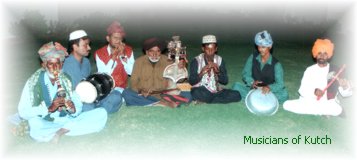|
Khanjari:
Khanjari is very simple in construction. Khanjari consists of an open round wooden frame which is about ten inches in diameter and two and a half inches wide. It is covered with skin on one side and the other side is left open. The frame or the rim has two parallel rows of jingle-plates and each plate is inserted in the frame held by a hole in the lower side. So when the Khanjari is shaken, a beautiful sound of a large number of jingle-plate is interacted with periodic structure of the beats on the covering.
While playing the Khanjari, it is held in the left and the palm and fingers of the right hand are used to strike the skin. Usually the skin remains so much stretched that while playing it one has to apply little water to make it loose for the required pitch. To produce the variety of sound, the skin is pressed near the rim with the four fingers.

Manjira and Jhanjha:
Manjira is the smallest in metal clapper's series. It is a pair of small and deep metallic cymbals, which are made of bronze or brass metal. The middle part of the cymbals is like a cup shape. They are circular discs and connected by a thread or cotton thread passing through a hole in their centers. The Manjira is struck mainly on the boundaries and is held by the circle.
It is used as rhythmic accompaniment in devotional music, folk music and dance. Experts can produce different attractive variations from this tiny instrument.
The Jhanjha – a rhythmic instrument – falls in the group of metal clappers and it is made of brass or bronze metal. It is a pair of very large size compact disk with graded central gloominess. The diameter of the Jhanjha is usually eight to ten inches and sometimes it is one foot also. In short, it has the largest edge. In the middle of the out side of the Jhanjha, there is a finger resting cord and while playing, it is definitely held by fingers and exclusively struck directly.
Jhanjha is played by hitting each other. The instrument when clashed, leave a deep follow up dull vibrate, which is included into the rhythmic progression. It is mainly played along with tasha and big dhol. Mostly, the Jhanjha is used in temple rituals and devotional singing like kirtan, bhajan and in religious procession.
Morchang:
Morchang or Chang is a simple but complicated sounding device made of iron or brass. It has an outer frame within is set a kind of thin expandable tuning division with its end protruding upwards. The player sets part of the frame between the teeth keeping the lips somewhat open so that the hollow of the mouth serves the purpose of a sound chamber. He than vibrates the tuning device by the soft backward strokes of his forefinger. Measured strokes in a slow or quick succession and an appropriate adjustment of the tongue position within the mouth are combined to produce a variety of rhythm patterns.

Morchang has been played by the shepherd community for a long time while grazing the cattle in jungle to appeal the cattle and for their own enjoyment. In south of India, It is known as Morshing. According to children's encyclopedia, it is accepted as jew's-harp. The Adivasis (aboriginals) of South Gujarat make the Morchang from bamboo which is played keeping it between the lips. Morchang is also found in Austria, Italy, Australia, Indonesia made from iron, but the sound of this Morchang is not as sweet as the sound of Kutchi Morchang has. Moreover, there is also difference in size and shape. Kutchi Morchang has better shape and sweet sound. In Kutch, Morchang is totally traditional and solo instrument which is played in folk style, while in South of India; it is used as a classical musical instrument supplementary other classical instrument for rhythm. Morchang has been played in Hindi films in back ground. To get better sound notes, the movement of tongue, throat and stomach is necessary.
|